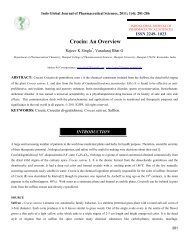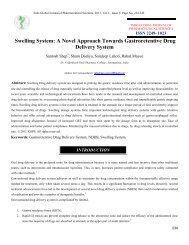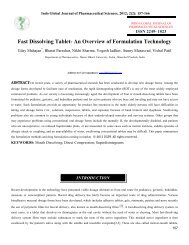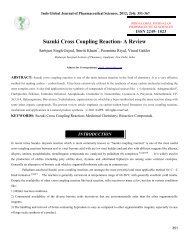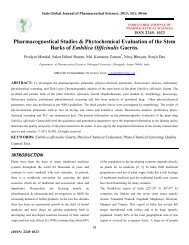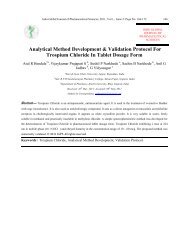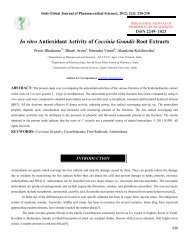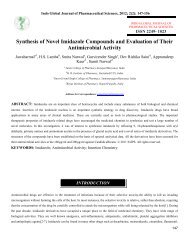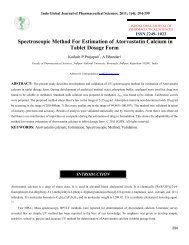Paramount Role of Solid Dispersion in Enhancement of Solubility
Paramount Role of Solid Dispersion in Enhancement of Solubility
Paramount Role of Solid Dispersion in Enhancement of Solubility
Create successful ePaper yourself
Turn your PDF publications into a flip-book with our unique Google optimized e-Paper software.
Indo Global Journal <strong>of</strong> Pharmaceutical Sciences, 2013; 3(1): 78-89<br />
Table 1: BCS calssification system<br />
Class <strong>Solubility</strong> Permeability Example <strong>of</strong> drugs<br />
Class I High solubility High permeability<br />
Benzapril, Loxopr<strong>of</strong>en,<br />
Sumatriptan etc.<br />
Class II High solubility High permeability<br />
Valsartan, Nimesulide,<br />
Loratad<strong>in</strong>e, Acecl<strong>of</strong>enac,<br />
Glimepiride etc.<br />
Class III High solubility How permeability<br />
Gabapent<strong>in</strong>e, Topiramate,<br />
Atrop<strong>in</strong>e etc.<br />
Class IV Low solubility Low permeability<br />
Hydrochlorthiazide, Furosemide,<br />
Meloxicam etc.<br />
Carriers<br />
Sugars<br />
Acids<br />
Polymeric Material<br />
Insoluble or enteric polymers<br />
Surfactants<br />
Miscellaneous<br />
Table 2: List <strong>of</strong> carriers used <strong>in</strong> solid dispersion<br />
Examples<br />
Dextrose, sucrose, lactose, sorbitol, maltose, mannitol, galactose<br />
Citric acids, succ<strong>in</strong>ic acids<br />
Povidone, polyethylene glycol, hydroxyl propyl methyl cellulose, methyl cellulose, hydroxyl<br />
ethyl, cellulose, pect<strong>in</strong><br />
Hydroxy propyl methyl cellulose phthalate, Eudrgit RS<br />
Polyoxyethylene stearate, Renex, Poloxamer 188, Tex<strong>of</strong>or AIP, Deoxycholioc acid, Tweens,<br />
Spans<br />
Urea, Hydroxyalkylxanth<strong>in</strong>s, Urethans<br />
A. First generation<br />
First generation solid dispersions are prepared us<strong>in</strong>g<br />
crystall<strong>in</strong>e carriers such as urea and sugar, which were the first<br />
carriers to be employed <strong>in</strong> solid dispersion. They have the<br />
disadvantage <strong>of</strong> form<strong>in</strong>g crystall<strong>in</strong>e solid dispersion, which are<br />
thermodynamically more stable and did not release the drug as<br />
quickly as amorphous ones. [3]<br />
B. Second generation<br />
Second generation solid dispersions <strong>in</strong>clude amorphous<br />
carriers <strong>in</strong>stead <strong>of</strong> crystall<strong>in</strong>e carriers which are usually<br />
polymers. These polymers <strong>in</strong>clude synthetic polymers such as<br />
povidone (PVP), polyethyleneglycols (PEG) and<br />
polymethacrylates as well as natural product based polymers<br />
such ashydroxylpropylmethyl-cellulose (HPMC), ethyl<br />
cellulose, and hydroxypropoylcellulose or starch derivates like<br />
cyclodextr<strong>in</strong>s. [3]<br />
C. Third generation<br />
Recently, it has been shown that the dissolution pr<strong>of</strong>ile can be<br />
improved if the carrier has surface activity or self emulsify<strong>in</strong>g<br />
properties. Therefore, third generation solid dispersions<br />
appeared. The use <strong>of</strong> surfactant such as <strong>in</strong>ul<strong>in</strong>, <strong>in</strong>utec SP1,<br />
compritol 888 ATO, gelucire 44/14 and poloxamer 407 as<br />
carriers are<br />
shown to be effective <strong>in</strong> orig<strong>in</strong>at<strong>in</strong>g high<br />
polymorphic purity and enhanced <strong>in</strong> vivo bioavailability.[3]<br />
CRITERIA FOR SELECTION OF<br />
CARRIERS USED IN SOLID DISPERSION<br />
The selection <strong>of</strong> the carrier has the <strong>in</strong>fluence on the dissolution<br />
characteristics <strong>of</strong> the dispersed drug. A water soluble carrier<br />
results <strong>in</strong> a faster release <strong>of</strong> the drug from the matrix.<br />
Classification <strong>of</strong> carriers is shown <strong>in</strong> table 2. An <strong>in</strong>soluble<br />
carrier leads to slower release <strong>of</strong> a drug from the matrix. The<br />
carriers to be used should have the follow<strong>in</strong>g characteristics:<br />
[4]<br />
Sugars<br />
‣ Readily soluble <strong>in</strong> water and <strong>in</strong> gastro<strong>in</strong>test<strong>in</strong>al fluids<br />
‣ Physiologically <strong>in</strong>ert<br />
‣ Melt<strong>in</strong>g po<strong>in</strong>t not much higher than that <strong>of</strong> drug<br />
‣ Thermal stability at melt<strong>in</strong>g temperature<br />
‣ Low vapor pressure<br />
‣ High molecular weight<br />
‣ Non toxic<br />
Although sugars and related compounds are highly water<br />
soluble but few sugars have toxicity issues, they are less<br />
suitable than other carriers for the manufacture <strong>of</strong> solid<br />
eISSN: 2249 1023<br />
80





